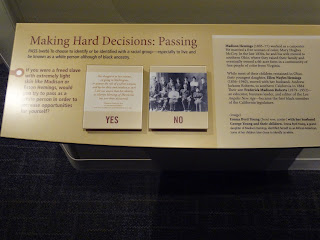I have memories of my grandmother passing down the oral history to us. There were quietly-told stories about our famous ancestors: it was just for us to know and pass on.
It was when I first read Sally Hemings: A Novel that I began taking the stories seriously. I wanted to know more; I wanted to get the facts; I wanted to confirm my ancestry. Then I read Thomas Jefferson and Sally Hemings: An American Controversy and that was when I saw the family tree in the front of the book that I got hooked on pursuing my ancestry.
1993
My very first visit to Monticello was May 7, 1993. I had never visited as a child. I only had the oral history of my family's relationship to Monticello and the little I was taught about the site in school. So I was unsure what to expect and unprepared for how I would feel. It was a bit overwhelming; so many emotions. It is very difficult to understand the impact slavery had on my ancestors. But while taking the house tour there was very little mention of slaves.
1999
Not long after the famous "DNA results" were published in 1998, there was a reunion planned for the Hemings family of Monticello. I wasn't able to attend the first "family reunion", but my sister did.
2001
May 2001 I returned with my husband and sister for another visit. The tours had changed: there was more information about how slavery supported the plantation, but it was still not presented as an integral part of life at Monticello.
2012
The Thomas Jefferson Foundation at Monticello collaborated with the Smithsonian Institution’s new National Museum of African American History and Culture (NMMAHC) on an exhibit of "Slavery at Jefferson’s Monticello: Paradox of Liberty" that covered slavery and enslaved people by looking at slavery on Jefferson’s Monticello plantation. The exhibition was on view at the Smithsonian Institution’s National Museum of American History in Washington D.C., from January to October 2012. My sister, brother and I spent a day studying the displays. It was so emotional to see our Madison Hemings ancestors featured right there in the Smithsonian!
2013
From February 22 to February 23, 2013, the Thomas Jefferson Foundation at Monticello hosted a unique symposium: "Telling the History of Slavery: Scholarship, Museum Interpretation, and the Public". At the Robert H. Smith Center at Montalto, academics and historic interpretures were joined with other symposium participants from the public; I registered my sister and I as soon as the symposium was opened to the public. The symposium was very educational and accepted the public's input. (It is great to see some of the input incorporated in the enhanced "Slavery at Monticello Tour" and the enhancements to Mulberry Row.)
I visited Poplar Forest May 2, 2013. While very similar to Monticello, I found the intimacy and simplicity of the house and grounds more appealing to my taste.
2015
So its been twenty two years since I first visited Monticello. I returned on May 2nd for the opening of Mulberry Row's enhancements and the reunion of the descendants of the slave families of Monticello. The program for the day was inspirational.
There were tree plantings along Mulberry Row and a tour of its new features. The recreated structures, impressive garden, and demonstrations seemed to bring a sense of life back to the row. (Note: Mulberry Row was the heart of the agricultural business and the industrial hub of Jefferson's 5000 acre plantation. As Monticello's main street, it was the center of every-day life for everyone on the plantation. It was quite busy with twenty dwellings, workshops, and storehouses between 1770 and 1831.)
I also had the opportunity to explore the Jefferson Library and the Robert H. Smith International Center for Jefferson Studies, a most impressive place in comparison to some of the other presidential libraries I have visited. (Note: The Robert H. Smith International Center for Jefferson Studies is on the Kenwood Campus. It supports a global network of Jefferson scholars. The advanced-technology center is located at the base of Monticello mountain; it focuses on research and supports other programs at Monticello.)
There was time for reflection at the Jefferson family cemetery and a prayer service at the slave cemetery.
Just as important I had the opportunity during the course of the weekend to meet and spend quality time with some of my cousins in person, some for the first time, during the course of the weekend.
My key Monticello References:
Brodie, Fawn M. Thomas Jefferson: An Intimate History. W. W. Norton & Company, 1974.
Chase-Riboud, Barbara. Sally Hemings: A Novel. Chicago Review Press. 1979.
Gordon-Reed, Annette. The Hemingses of Monticello: An American Family. New York; W. W. Norton & Company, 2008.
Gordon-Reed, Annette. Thomas Jefferson and Sally Hemings: An American Controversy. Charlottesville; University of Virginia Press, 1997, 1998.
Miller, John Chester. The Wolf by the Ears: Thomas Jefferson and Slavery. Charlottesville; University Press of Virginia, 1991.
Stanton, Lucia. Slavery at Monticello. Charlottesville: Thomas Jefferson Foundation, 1996.
Stanton, Lucia. Those Who Labor for My Happiness: Slavery at Thomas Jefferson's Monticello. Charlottesville, VA; University of Virginia Press, 2012.









